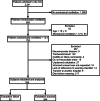Effect of Reintubation Within 48 Hours on Mortality in Critically Ill Patients After Planned Extubation
- PMID: 38772683
- PMCID: PMC11285505
- DOI: 10.4187/respcare.11077
Effect of Reintubation Within 48 Hours on Mortality in Critically Ill Patients After Planned Extubation
Abstract
Background: Re-intubation is necessary in 2% to 30% of cases of patients receiving a planned extubation. This procedure is associated with prolonged mechanical ventilation, a greater need for tracheostomy, a higher incidence of ventilator-associated pneumonia, and higher mortality. The aim of this study was to evaluate the effect of re-intubation within 48 h on mortality after planned extubation by using a randomized controlled trial database.
Methods: Secondary analysis of a multi-center randomized trial, which evaluated the effect of reconnection to mechanical ventilation for 1 h after a successful spontaneous breathing trial, followed by extubation. The study included adult subjects who received invasive mechanical ventilation for > 12 h. The subjects were divided into an extubation failure group and an extubation success group. The outcome was in-hospital mortality. Two multivariate logistic regression models were constructed to identify independent factors associated with mortality.
Results: Among the 336 subjects studied, extubation failed in 52 (15.4%) and they were re-intubated within 48 h. Most re-intubations occurred between 12 and 24 h after planned extubation (median [interquartile range] 16 [6-36] h). Mortality of the extubation failure group was higher both in the ICU (32.6% vs 6.6%; odds ratio [OR] 6.77, 95% CI 3.22-14.24; P < .001) and in-hospital (42.3% vs 14.0%; OR 4.47, 95% CI 2.34-8.51; P < .001) versus the extubation success group. Multivariate logistic regression analyses showed that re-intubation within 48 h was independently associated with both ICU mortality (OR 6.10, 95% CI 2.84-13.07; P < .001) and in-hospital mortality (OR 3.36, 95% CI 1.67-6.73; P = .001). In-hospital mortality was also associated with rescue noninvasive ventilation after extubation (OR 2.44, 95% CI 1.25-4.75; P = .009).
Conclusions: Re-intubation within 48 h after planned extubation was associated with mortality in subjects who were critically ill.
Keywords: extubation; mechanical ventilation; mortality; re-intubation; ventilator weaning.
Copyright © 2024 by Daedalus Enterprises.
Conflict of interest statement
The authors have disclosed no conflicts of interest.
Figures


References
-
- Rello J, Ollendorf DA, Oster G, Vera-Llonch M, Bellm L, Redman R, Kollef MH; VAP Outcomes Scientific Advisory Group. Epidemiology and outcomes of ventilator-associated pneumonia in a large US database. Chest 2002;122(6):2115-2121. - PubMed
-
- Gajic O, Dara SI, Mendez JL, Adesanya AO, Festic E, Caples SM, et al. Ventilator-associated lung injury in patients without acute lung injury at the onset of mechanical ventilation. Crit Care Med 2004;32(9):1817-1824. - PubMed
-
- Esteban A, Frutos F, Tobin MJ, Alía I, Solsona JF, Valverdú I, et al. A comparison of four methods of weaning patients from mechanical ventilation. Spanish Lung Failure Collaborative Group. N Engl J Med 1995;332(6):345-350. - PubMed
-
- Fernandez MM, González-Castro A, Magret M, Bouza MT, Ibañez M, García C, et al. Reconnection to mechanical ventilation for 1 h after a successful spontaneous breathing trial reduces reintubation in critically ill patients: a multicenter randomized controlled trial. Intensive Care Med 2017;43(11):1660-1667. - PubMed
Publication types
MeSH terms
LinkOut - more resources
Full Text Sources

